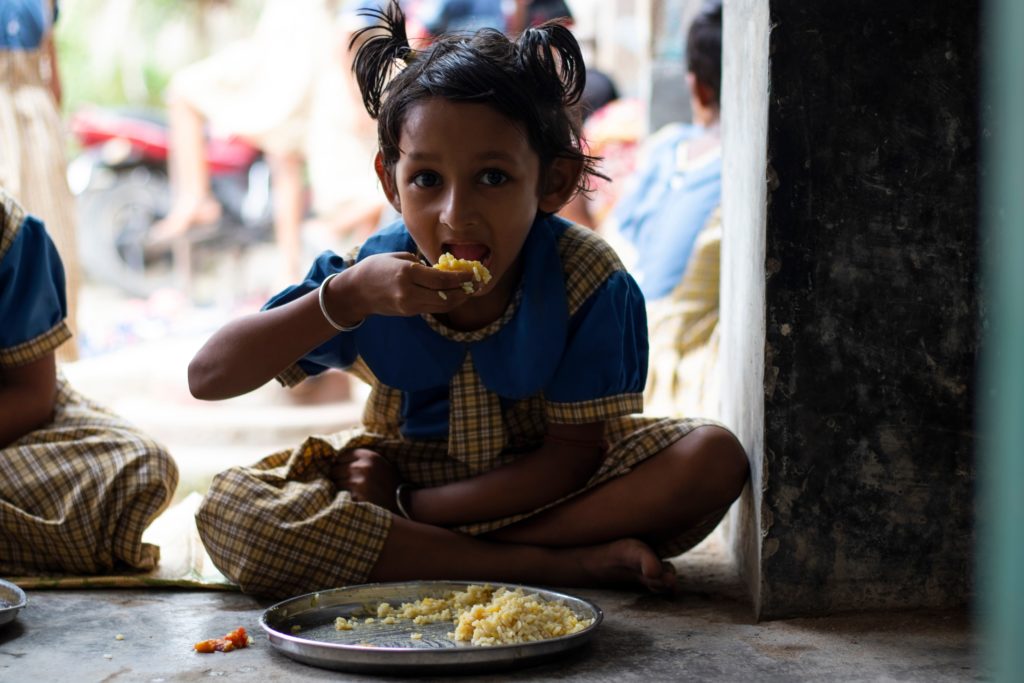The right to adequate food is a fundamental human right. Without it, children face significant mental and physical health risks, which in the most extreme cases can be life-threatening. Children are therefore entitled to basic food security – the minimum nutrition required to survive – as well as ‘adequate’ food: access to sustainable and nutritious food sources that enable them to live healthy lives. However, increasingly, both these needs are under threat.

Global food insecurity and its impact on children
As of 2023, the World Food Program estimated more than 345 million people were facing severe hunger – an alarming increase of nearly 200 million since 2020 (World Food Program USA, 2023). Children are particularly vulnerable to global food insecurity: one in four children lives in severe poverty through early childhood, amounting to a total of 181 million children under the age of five (UNICEF, 2024).
Furthermore, a growing and global consumerist culture has undermined the nutritious benefits of the food children can access. At least 340 million children suffer from “hidden hunger”, characterized by deficiencies in essential vitamins and minerals. At the same time, 40 million children under the age of five are overweight and the prevalence of overweight and obesity keeps rising, even in lower-income countries (UNICEF, 2019).
Children’s right to food
Children’s inalienable rights to food and adequate nutrition are enshrined in several cornerstone international conventions and guidelines. Primarily, Articles 24 and 27 of the United Nations Convention on the Rights of the Child (UNCRC, 1989):
- Ensure the provision of healthcare and medical assistance
- Combat disease and malnutrition, including ‘… the provision of adequate, nutritious foods and clean drinking-water’
- Ensure all members of society, emphasizing parents and children, ‘have access to education and are supported in the use of basic knowledge of child health and nutrition…’
- Ensure parents and those responsible for children ‘secure, within their abilities and financial capacities, the conditions of living necessary for the child’s development.’
- Ensure states ‘take appropriate measures to assist parents and others responsible for the child to…’ ‘…provide material assistance and support program, particularly with regard to nutrition, clothing and housing’
Further, Target 2.2 of the United Nations Sustainable Development Goals commits all member states towards the 2030 goal of ending ‘all forms of malnutrition, including achieving, by 2025, the internationally agreed targets on stunting and wasting in children under 5 years of age, and address the nutritional needs of adolescent girls, pregnant and lactating women and older persons’ (United Nations Department of Economic and Social Affairs, 2015).
These rights are aligned to Article 25 of the Universal Declaration of Human Rights which, under provisions necessitating the provision of an adequate standard of living for all, urges states to ensure ‘access to food..’ including that this food is ‘adequate’ (UN General Assembly, 1948)
Understanding food insecurity and food environments
The United Nations Food and Agriculture Organization defines a person as food insecure when they lack ‘regular access to enough safe and nutritious food for normal growth and development’. As such, food must be both accessible and sufficiently nutritious. Hunger is defined as ‘an uncomfortable or painful physical sensation caused by insufficient consumption of dietary energy’ (UNFAO, n.d).
A food environment is an ecosystem within which food is harvested, prepared, distributed and consumed. Broadly, these structures can be broken down into three categories.
External food environment
External food environments define the socioeconomic, political, and cultural systems which affect the supply and demand for food. These are places and institutions that supply food – including farms, shops, markets, and other vendors – as well as entities working to influence the supply chain – such as advertising companies and institutions that affect food regulation (UNICEF, 2019).
Personal food environment
The personal food environment refers to the household and individual-level factors that affect people’s ability to access and consume food in a sustainable way. These include financial conditions, geographical proximity to food sources and cultural factors, among others (UNICEF, 2019).
Obesogenic food environments
Obesogenic food environments are those in which healthy foods are either limited in availability, accessibility (including affordability) or desirability, leading to unhealthy child populations. These environments can be exacerbated by aggressive marketing campaigns from unhealthy food providers, large portion sizes, poor regulation of food labelling and restricted or absent education on food health. These factors, individually or in combination, contribute to unhealthy behaviors within child populations and family structures (UNICEF, 2019).
Global prevalence of food insecurity and unhealthy food environments
Food insecurity

Regionally, Africa holds the largest estimated proportion of the population facing food insecurity, with 20.4 % of the continent grappling with hunger, compared to just over 8% in Asia and 6 % in Latin America. In absolute terms, it is estimated that 385 million people in Asia and a further 300 million in Africa are affected by hunger (UNFAO, 2024). Children are particularly affected; globally, over 148 million children lack sufficient meals and access to proper health and nutrition services (Action Against Hunger, 2024).
Additionally, an estimated 45 million young children suffer from severe malnutrition annually (Children International, n,d). Ahead of the 2022 G7 summit, UNICEF highlighted that the global hunger crisis was pushing one child every 15 minutes into severe malnutrition, putting over 8 million children at risk of death (UNICEF, 2022).
Unhealthy food environments
The continued rise of vitamin and mineral deficiencies, alongside growing obesity rates, reflects the rapid growth of unhealthy food environments. UNICEF approximates that nearly 70% of all children do not receive the minimum diverse diet required for sustainable and healthy development. From an economic perspective, the best estimates value the impact of global obesity at around US$2 trillion, nearly 3 percent of the global GDP and an equivalent ‘cost’ to global armed conflict or smoking (UNICEF, 2022).
The causes and drivers of food insecurity
Food insecurity in children can arise from a variety of interrelated causes, including:
Poverty
Financial hardship is one of the main drivers of food insecurity. Children who lack the means to purchase or receive sufficient and adequate food are at risk of malnutrition. A 2024 UNICEF report on child food poverty highlighted that children living in severe child food poverty were lacking in many nutrient-rich foods and frequently displayed entrenched unhealthy diets (UNICEF, 2024).
Climate change and natural disasters
Extreme weather conditions driven by climate change – including floods, droughts, mudslides and wildfires – can dramatically affect food production in arable areas, and those that host natural foods. Natural disasters can also drive populations into poverty by destroying critical environments.
Estimates suggest the global risk of poverty and malnutrition could increase by up to 20% in the next 25 years if measures aren’t put in place to counteract current trends (Action Against Hunger, 2024). Approximately 80% of the most at-risk populations from climate-change-driven hunger are located in Sub-Saharan Africa, and South and Southeast Asia– regions that also have the world’s most impoverished communities (World Bank, 2022).
War and conflict
Armed conflict is considered the single biggest driver of world hunger. Conflict not only damages arable and food-producing land but also disrupts crop-producing economies and pushes millions of vulnerable people into poverty each year (Action Against Hunger, 2024).
Unemployment
Tied to the effects of poverty, children inhabiting households where the primary income earner(s) experience unemployment are often placed into vulnerable situations. The global unemployment rate has remained relatively constant since 2022 at between 5.1% and 5.3% (International Labor Organization, 2024). Unemployment can fluctuate dramatically and is inherently connected to other socioeconomic factors: in 2020 and following the Covid-19 pandemic, global unemployment jumped to 6.6% (O’Neill, 2024).
Socio-economic background
Children from disadvantaged socio-economic backgrounds are disproportionately at risk of food insecurity. Studies from the United States of America illustrated strong correlations between low wages, residential segregation, and a lack of affordable housing (Drewnowski, 2022).
High cost of food or the inability to access food
Rising food prices and other associated costs – including travel, taxes and broader living expenses– directly inhibit children from being able to access nutritious food. Research from the United Kingdom following the COVID-19 pandemic portrayed a year-on-year decrease in average disposable income: as of 2022, the poorest 20% of the country needed to spend 50% of their income to secure the government-recommended healthy diet (The Food Foundation, 2023).
Social exclusion
Theories of social exclusion describe the ways in which unequal access to rights and societal resources leads to socioeconomic, political, and cultural vulnerabilities. Research from 2023 links this phenomenon to health disparities, showcasing the ways in which discrimination can lead to food insecurity (Brady et al, 2023). Discrimination of this kind can include residential health ‘black spots’, areas of urbanized or rural economies which are ignored and fail to benefit from the same protection mechanisms as other parts of society.
Poor policy frameworks
Against the backdrop of rising capitalism, national and international regulators are struggling to curb corporate marketing campaigns and the production and distribution of unhealthy foods. Stronger mechanisms are required to limit the private sector’s role in shaping food policy. UNICEF has recommended involving the private sector in the implementation of policies affecting children, but excluding it from policy development to prevent conflicts of interest (UNICEF, 2019).
Socioeconomic and cultural factors
Multiple socioeconomic and cultural factors contribute to unhealthy food habits and practices. Pervasive and relentless corporate marketing for unhealthy foods – exacerbated by the proliferation of child-accessible social and other media – encourages children to eat unhealthy processed foods – and simultaneously offers parents and carers an affordable way to feed their children.
This has been reprimanded by the Special Rapporteur on the Right to Food. Religious and cultural traditions can also drive unhealthy food habits: traditional diets do not benefit from contemporary research and evidence on what constitutes a healthy diet.
The significance of these and other socioeconomic factors is supported by 2019 UNICEF research, which indicates severe food poverty is experienced in both poor and wealthy households. For instance, wealthier families experience “time poverty”, whereby they do not always have enough time to ensure that children are eating home-cooked, well-balanced and nutritious meals regularly (UNICEF, 2019).
Lack of food education
Children are especially susceptible to the trappings of emotion-based marketing strategies deployed by companies selling unhealthy foods. Additionally, parents and carers are not always exposed to the information required to support them in making healthy food choices for their families.
Manipulative food marketing campaigns are therefore disproportionately targeted at disadvantaged children and families from socioeconomic and cultural backgrounds, taking advantage of knowledge gaps and inadequate education mechanisms (UNICEF, 2019). If educational institutions and governments fail to disseminate learning about healthy foods and how to access them, communities can fall into unhealthy eating cycles.
The impact of food insecurity
Food insecurity can have a devastating and lasting impact on children. This can impact several aspects of their development.
Physical health challenges
Children who do not receive adequate nutrition are at risk of malnutrition, stunting, obesity and death. In 2022, the World Health Organization reported that ‘149 million children under the age of five were estimated to be stunted (too short for age), 45 million were estimated to be wasted (too thin for height), and 37 million were overweight or living with obesity’.

This is in addition to the studied mortalities: nearly half of the studied deaths of under-five-year-olds were linked to undernutrition (World Health Organization, 2024). In the same year, UNICEF observed that approximately 22.3% of children under the age of five globally were affected by stunting, with a majority of these children living in South Asia and sub-Saharan Africa (UNICEF, 2023).
Global obesity numbers amongst children are also rising. According to the World Health Organization, ‘Over 390 million children and adolescents aged 5–19 years were overweight in 2022, including 160 million who were living with obesity’. (World Health Organization, 2024). Children with obesity are at higher risk of developing further diseases and mental health challenges, including developmental difficulties: children who are overweight generally score lower on cognitive tests (UNICEF, 2019).
Research also highlights the economic burden of obesity, affecting both families and societies. Though commonly associated with Western countries, in 2022 the highest rates of overweight children under the age five were observed in the Middle East and North Africa: 10.3% of children under five, relative to 8.6% and 8.2% respectively in Latin America and the Caribbean, and North America (UNICEF, 2023).
Mental health and cognitive development
Food insecurity infringes on child development by exposing them to higher risks of mental health illnesses and undermining their overall healthy development. The connection between food insecurity and mental health challenges is well documented: research from 2021 from the United States of America indicates that greater levels of food insecurity are associated with a 257% increase in the risk of anxiety, and a 253% in the risk of depression (Fang et al, 2021).
Similarly, research from 2024 conducted in the United Kingdom revealed that 50% of surveyed individuals suffering from severe mental illness in the north of the country were unable to afford food (Bell, 2024).
School attendance and academic performance
School attendance provides children with an opportunity to access information about healthy food and practice healthy eating habits. Educational programs often emphasize nutrition, teaching children the importance of balanced diets and the potential health risks associated with ultra-processed foods. In contexts where free school meals are provided, these can be crucial sources of nutrition: a landmark 2020 campaign in the United Kingdom evidenced the vital importance of free school meals for millions of the country’s children.
In turn, children who come from food-secure households are also more likely to maintain school attendance: studies from the United States of America demonstrate lower attendance among children with higher household food insecurity rates (Coughenour et al, 2021). In many communities, household food insecurity also creates financial pressures that drive children towards child labor, ridding them of the opportunity to attend and complete their schooling.
Social stigmatization
Individuals experiencing poverty and food insecurity face stigmatization: both socially – from those who have preconceived ideas about impoverished people – and structurally, through inequitable support mechanisms. Government assistance schemes can discriminate against those in need by putting them in vulnerable situations.
This can manifest in several ways: individuals may experience humiliation when accessing charitable services, undergo intrusive assessments that scrutinize their daily lives and choices, and face abuses of power, such as an employer exploiting workers who are in disadvantaged circumstances (Guardia & Lacko, 2021).
Recommendations to support children’s right to food
Governments and regional bodies must take several steps to establish sustainable, healthy food environments, in accordance with the Convention on the Rights of the Child. These approaches must prioritize the best interests of the child and recognize the importance of nutrition, particularly among existing vulnerable populations. At the very least, governments should (UNICEF, 2019):
- Develop and implement policies to guarantee long-term, accessible and nutritious food, and sustainable food environments.
- Develop and implement a policy to ensure children are protected from exploitative marketing campaigns related to unhealthy foods.
- Develop and implement policies to guarantee food industry standards and sanction non-compliance.
- Establish and deliver educational campaigns targeted at different age groups to realize greater levels of knowledge about healthy food and nutrition, empowering families and children to better monitor their food consumption.
- Ensure medical and health services are resourced to support the physical and mental health impacts of food insecurity on children.
- Ensure policy forums recognize the root drivers of food insecurity and develop holistic responses to cross-cutting socioeconomic problems.
Key international and legal instruments
The United Nations Convention on the Rights of the Child presents the right to adequate nutrition as a fundamental human right, owing to its necessity for the realization of further rights and freedoms. Despite this, the international framework of guidelines and regulations is fragmented.
The Committee on the Rights of the Child has issued numerous General Comments urging states to combat malnutrition and realize healthy food environments; these are supplemented by the United Nations Food and Agriculture Organization’s Voluntary Guidelines to Support the Progressive Realization of the Right to Adequate Food in the Context of National Food Security. Notwithstanding their ‘voluntary’ nature, these guidelines are the primary international tools designed to support states in the design and implementation of counter-food insecurity programs and policies (UNICEF, 2019).

At a broader level, there are several key international and legal instruments that recognize and respond to children’s right to food, including:
- United Nations Convention on the Rights of the Child
- African Charter on the Rights and Welfare of the Child
- General Comment No. 15 (2013) on the rights of the child to the enjoyment of the highest attainable standard of health (Article 24)
- General Comment No. 16 (2013) on State obligations regarding the impact of the business sector on children’s rights
- United Nations Guiding Principles on Business and Human Rights
- OECD Guidelines for multinational enterprises on responsible business conduct
- International Covenant on Economic, Social and Cultural Rights
- Universal Declaration of Human Rights
Written by Vanessa Cezarita Cordeiro
Internally proofread by Aditi Partha
Last updated on 6 October 2024
References:
Action Against Hunger. (2024). “World Hunger Facts.” Retrieved from Action Against Hunger, accessed on 28 September 2024.
Bell, A. “The severity of food insecurity among people with a mental illness.” (2024, May 3). Retrieved from Center for Mental Health, accessed on 27 September 2024.
Brady, P., Askelson, N., Ashida, S., Nothwehr, F., Janssen, B., Frisvold, D. (2021, November). “The relationship between political, economic, social and cultural vulnerability and food insecurity among adults aged 50 years and older.” Retrieved from PubMed Central, accessed on 27 September 2024.
Children International. (n,d). “Global poverty and hunger.” Retrieved from Children International, accessed on 28 September 2024.
Coughenour, C., Conway Kleven, B., Gakha, M., Stephen, H., Chien, LC., Labus, B., Whaley, R. (2021, October 24). “School absenteeism is linked to household food insecurity in school catchment areas in Southern Nevada.” Retrieved from Public Health Nutrition, accessed on 28 September 2024.
DiFang., Thomsen, M., Nayga, R. (2021, March 29). “The association between food insecurity and mental health during the COVID-19 pandemic.” Retrieved from BMC Public Health, accessed on 27 September 2024.
Drewnowski, A. (2022, August 8). “Food insecurity has economic root causes.” Retrieved from PubMed Central, accessed on 25 September 2024.
Food and Agriculture Organization of the United Nations, International Fund for Agricultural Development, UNICEF, World Food Program & World Health Organization. (2024). “The state of food security and nutrition in the world in 2024.” Retrieved from Food and Agriculture Organization of the United Nations, accessed on 27 September 2024.
Food and Agriculture Organization of the United Nations. (n,d). “Hunger and food insecurity.” Retrieved from Food and Agriculture Organization of the United Nations, accessed on 29 September 2024.
Food Foundation. (2023). “The Broken Plate: The state of the nation’s food system.” Retrieved from The Food Foundation, accessed on 29 September 2024.
Food Research and Action Center. (2021, December 1). “To end hunger, we must end stigma.” Retrieved from Food Research and Action Center (FRAC), accessed on 29 September 2024.
International Labour Organization. (2024, January 10). “Global unemployment rate set to increase in 2024 while growing social inequalities raise concerns, says ILO report.” Retrieved from International Labour Organization, accessed on 29 September 2024.
O’Neill, A. (2024, September 27). “Global unemployment rate from 2004 to 2023.” Retrieved from Statista, accessed on 29 September 2024.
UN General Assembly. (1948, December 10). “The Universal Declaration of Human Rights.” Retrieved from United Nations Human Rights Office of the High Commissioner, accessed 28 September 2024.
UNICEF. (2019). “Protecting children’s right to a healthy food environment.” Retrieved from UNICEF, accessed on 25 September 2024.
UNICEF. (2022, June 22). “Global hunger crisis pushing one child into severe malnutrition every minute in 15 crisis-hit countries.” Retrieved from UNICEF, accessed 28 September 2024.
UNICEF. (2023, May). “Child malnutrition.” Retrieved from UNICEF, accessed on 25 September 2024.
UNICEF. (2024, June). “Child food poverty nutrition deprivation in early childhood.” Retrieved from UNICEF, accessed on 28 September 2024.
United Nations Convention on the Rights of the Child. (20 November 1989). General Assembly Resolution 44/25. Retrieved from United Nations Human Rights Office of the High Commissioner, accessed on 27 September 2024.
United Nations Department of Economic and Social Affairs. (2015, September 25). “United Nations Sustainable Development Goals, Goal 2: Zero hunger.” Retrieved from United Nations Sustainable Development Goals, accessed on 28 September 2024.
World Food Program USA. (2023, October 5). “Fall impact report: An update on WFP’s response to a global hunger crisis.” Retrieved from World Food Program USA, accessed on 28 September 2024.
World Bank Group. (2022, October 17). “What you need to know about food security and climate change.” Retrieved from World Bank Group, accessed on 29 September 2024.
World Health Organization. (2024, March 1). “Obesity and overweight key facts.” Retrieved from World Health Organization, accessed 27 September 2024.
World Health Organization. (2024, March 1). “Malnutrition key facts.” Retrieved from World Health Organization, accessed on 27 September 2024.

